2008 KIA Sportage engine oil
[x] Cancel search: engine oilPage 308 of 350
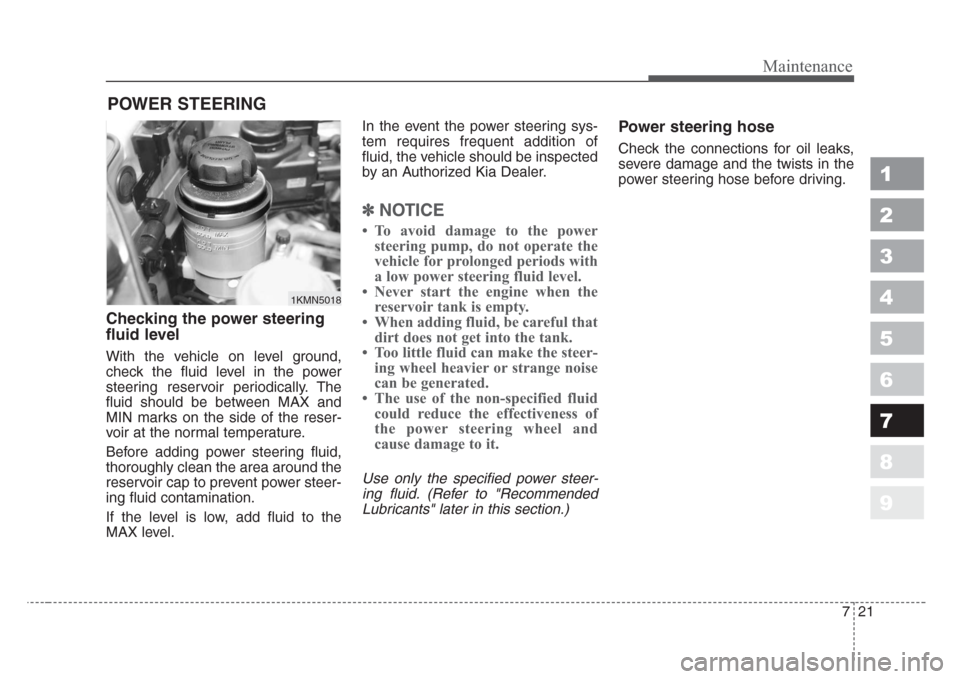
721
Maintenance
1
2
3
4
5
6
7
8
9
POWER STEERING
Checking the power steering
fluid level
With the vehicle on level ground,
check the fluid level in the power
steering reservoir periodically. The
fluid should be between MAX and
MIN marks on the side of the reser-
voir at the normal temperature.
Before adding power steering fluid,
thoroughly clean the area around the
reservoir cap to prevent power steer-
ing fluid contamination.
If the level is low, add fluid to the
MAX level.In the event the power steering sys-
tem requires frequent addition of
fluid, the vehicle should be inspected
by an Authorized Kia Dealer.
✽
NOTICE
• To avoid damage to the power
steering pump, do not operate the
vehicle for prolonged periods with
a low power steering fluid level.
• Never start the engine when the
reservoir tank is empty.
• When adding fluid, be careful that
dirt does not get into the tank.
• Too little fluid can make the steer-
ing wheel heavier or strange noise
can be generated.
• The use of the non-specified fluid
could reduce the effectiveness of
the power steering wheel and
cause damage to it.
Use only the specified power steer-
ing fluid. (Refer to "Recommended
Lubricants" later in this section.)
Power steering hose
Check the connections for oil leaks,
severe damage and the twists in the
power steering hose before driving.
1KMN5018
Page 311 of 350

Maintenance
24 7
1
2
3
4
5
6
7
8
9
✽
NOTICE
“COLD” scale is for reference only
and should NOT be used to deter-
mine transaxle fluid level.
✽
NOTICE
New automatic transaxle fluid
should be red. The red dye is added
so the assembly plant can identify it
as automatic transaxle fluid and dis-
tinguish it from engine oil or
antifreeze. The red dye, which is not
an indicator of fluid quality, is not
permanent. As the vehicle is driven,
the automatic transaxle fluid will
begin to look darker. The color may
eventually appear light brown.
Therefore, have an Authorized Kia
dealer change the automatic
transaxle fluid according to the
Scheduled Maintenance at the
beginning of this section.
Changing the automatic
transaxle fluid
Have automatic transaxle fluid
changed by an Authorized Kia
Dealer according to the Maintenance
Schedule at the beginning of this
section.
Use only the specified automatic
transaxle fluid. (Refer to
"Recommended Lubricants" later in
this section.)
CAUTION
• Low fluid level causes
transaxle slippage.Overfilling
can cause foaming, loss of fluid
and transaxle malfunction.
• The use of a non-specified fluid
could result in transaxle mal-
function and failure.
WARNING- Parking brake
To a v oid sudden movement of
the vehicle, apply parking brake
and depress the brake pedal
before moving the shift lever.
WARNING -Transaxle
fluid
The transaxle fluid level should
be checked when the engine is at
normal operating temperature.
This means that the engine, radi-
ator, radiator hose and exhaust
system etc., are very hot.
Exercise great care not to burn
yourself during this procedure.
Page 313 of 350
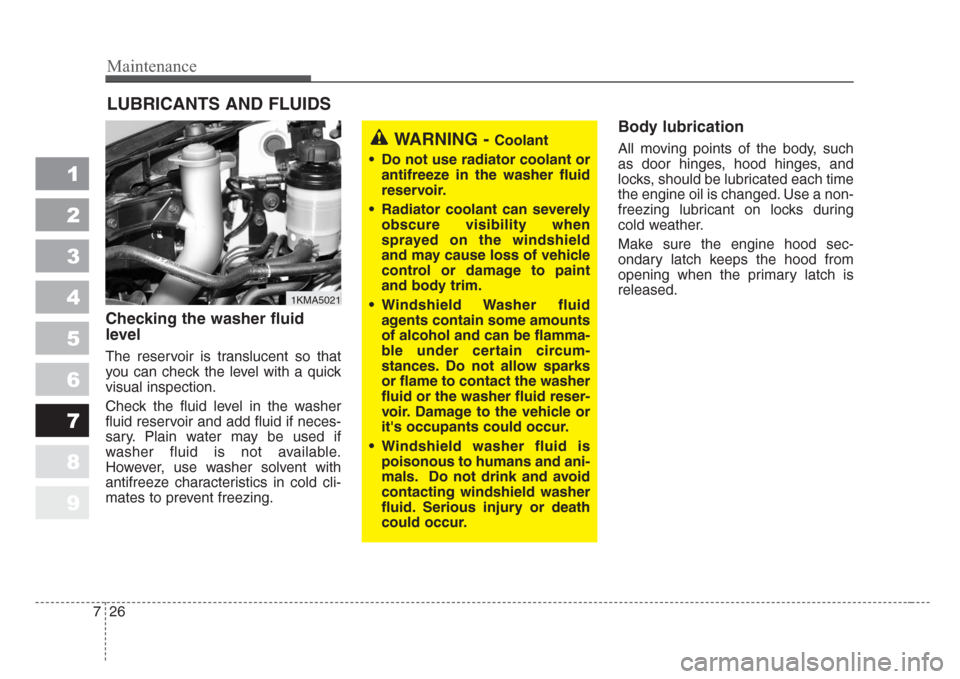
Maintenance
26 7
1
2
3
4
5
6
7
8
9
LUBRICANTS AND FLUIDS
Checking the washer fluid
level
The reservoir is translucent so that
you can check the level with a quick
visual inspection.
Check the fluid level in the washer
fluid reservoir and add fluid if neces-
sary. Plain water may be used if
washer fluid is not available.
However, use washer solvent with
antifreeze characteristics in cold cli-
mates to prevent freezing.
Body lubrication
All moving points of the body, such
as door hinges, hood hinges, and
locks, should be lubricated each time
the engine oil is changed. Use a non-
freezing lubricant on locks during
cold weather.
Make sure the engine hood sec-
ondary latch keeps the hood from
opening when the primary latch is
released.
1KMA5021
WARNING - Coolant
• Do not use radiator coolant or
antifreeze in the washer fluid
reservoir.
• Radiator coolant can severely
obscure visibility when
sprayed on the windshield
and may cause loss of vehicle
control or damage to paint
and body trim.
•Windshield Washer fluid
agents contain some amounts
of alcohol and can be flamma-
ble under certain circum-
stances.Do not allow sparks
or flame to contact the washer
fluid or the washer fluid reser-
vo
ir.Damage to the vehicle or
it's occupants could occur.
•Windshield washer fluid is
poisonous to humans and ani-
mals.Do not drink and avoid
contacting windshield washer
fluid.Serious injury or death
could occur.
Page 320 of 350
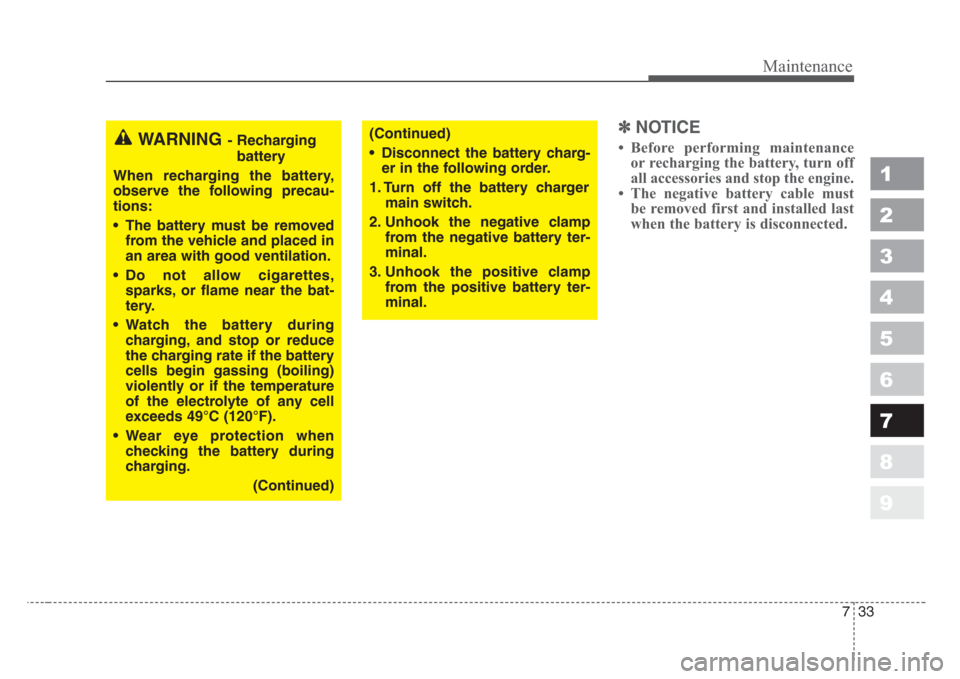
733
Maintenance
1
2
3
4
5
6
7
8
9
✽
NOTICE
• Before performing maintenance
or recharging the battery, turn off
all accessories and stop the engine.
• The negative battery cable must
be removed first and installed last
when the battery is disconnected.WARNING- Recharging
battery
When recharging the battery,
observe the following precau-
tions:
• The battery must be removed
from the vehicle and placed in
an area with good ventilation.
• Do not allow cigarettes,
sparks, or flame near the bat-
tery.
• Watch the battery during
charging, and stop or reduce
the charging rate if the battery
cells begin gassing (boiling)
violently or if the temperature
of the electrolyte of any cell
exceeds 49°C (120°F).
• Wear eye protection when
checking the battery during
charging.
(Continued)(Continued)
•Disconnect the battery charg-
er in the following order.
1.Turn off the battery charger
main switch.
2.Unhook the negative clamp
from the negative battery ter-
minal.
3.Unhook the positive clamp
from the positive battery ter-
minal.
Page 335 of 350
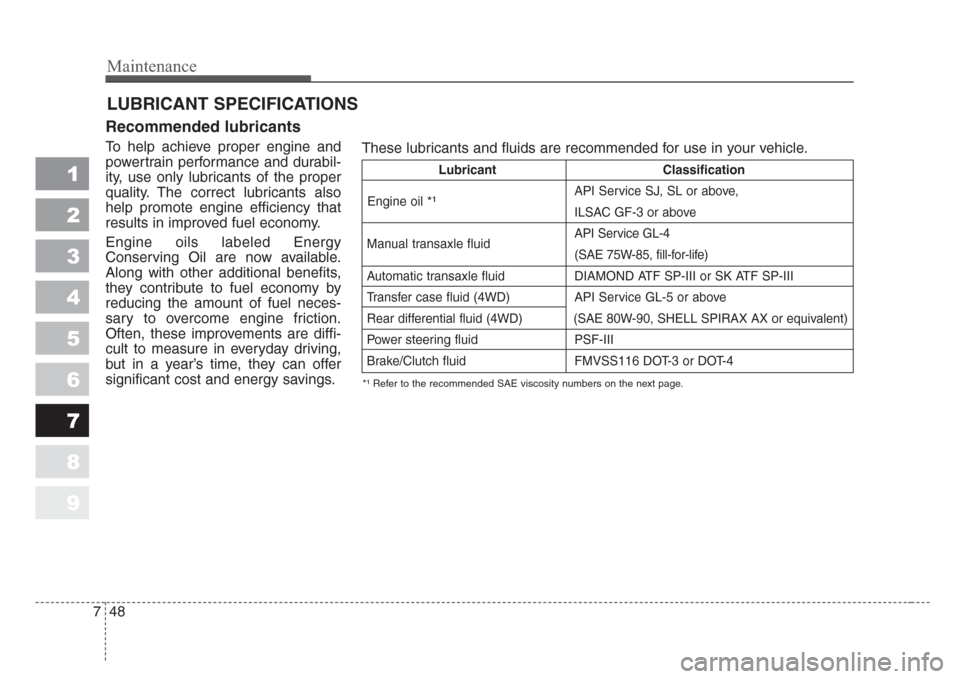
Maintenance
48 7
1
2
3
4
5
6
7
8
9
LUBRICANT SPECIFICATIONS
Recommended lubricants
To help achieve proper engine and
powertrain performance and durabil-
ity, use only lubricants of the proper
quality. The correct lubricants also
help promote engine efficiency that
results in improved fuel economy.
Engine oils labeled Energy
Conserving Oil are now available.
Along with other additional benefits,
they contribute to fuel economy by
reducing the amount of fuel neces-
sary to overcome engine friction.
Often, these improvements are diffi-
cult to measure in everyday driving,
but in a year’s time, they can offer
significant cost and energy savings.
*¹ Refer to the recommended SAE viscosity numbers on the next page.
These lubricants and fluids are recommended for use in your vehicle.
Lubricant Classification
API Service SJ, SL or above,
ILSAC GF-3 or above
Manual transaxle fluid API Service GL-4
(SAE 75W-85, fill-for-life)
Automatic transaxle fluid DIAMOND ATF SP-III or SK ATF SP-III
Transfer case fluid (4WD) API Service GL-5 or above
Rear differential fluid (4WD) (SAE 80W-90, SHELL SPIRAX AX or equivalent)
Power steering fluid PSF-III
Brake/Clutch fluid FMVSS116 DOT-3 or DOT-4
Engine oil *¹
Page 336 of 350

749
Maintenance
1
2
3
4
5
6
7
8
9
Recommended SAE viscosity
number
✽
NOTICE
Always be sure to clean the area
around any filler plug, drain plug,
or dipstick before checking or drain-
ing any lubricant. This is especially
important in dusty or sandy areas
and when the vehicle is used on
unpaved roads. Cleaning the plug
and dipstick areas will prevent dirt
and grit from entering the engine
and other mechanisms that could be
damaged.
Engine oil viscosity (thickness) has
an effect on fuel economy and cold
weather operating (starting and oil
flow). Lower viscosity engine oils can
provide better fuel economy and cold
weather performance, however,
higher viscosity engine oils are
required for satisfactory lubrication in
hot weather. Using oils of any viscos-
ity other than those recommended
could result in engine damage.When choosing an oil, consider the
range of temperature your vehicle
will be operated in before the next oil
change. Proceed to select the rec-
ommended oil viscosity from the
chart.
Temperature Range for SAE Viscosity Numbers
Temperature
Gasoline
Engine Oil°C
(°F)-30 -20 -10 0 10 20 30 40 50
-10 0 20 40 60 80 100 120
10W-30
5W-20, 5W-30
Page 345 of 350
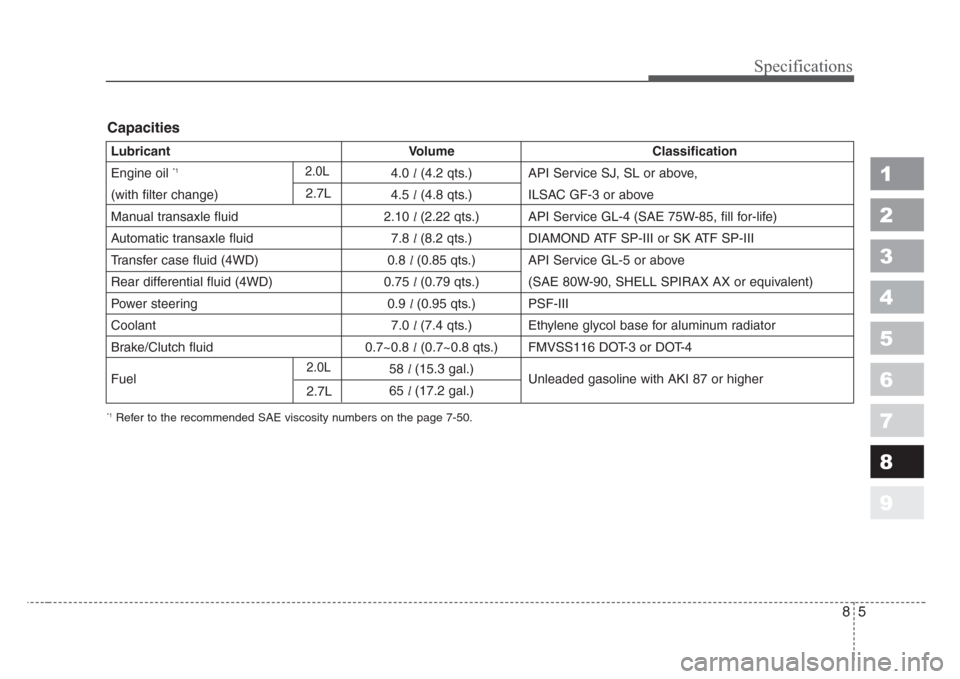
85
1
2
3
4
5
6
7
8
9
Specifications
*1Refer to the recommended SAE viscosity numbers on the page 7-50.
Lubricant Volume Classification
Engine oil
*14.0l(4.2 qts.) API Service SJ, SL or above,
(with filter change) 4.5 l(4.8 qts.) ILSAC GF-3 or above
Manual transaxle fluid 2.10 l(2.22 qts.) API Service GL-4 (SAE 75W-85, fill for-life)
Automatic transaxle fluid 7.8 l(8.2 qts.) DIAMOND ATF SP-III or SK ATF SP-III
Transfer case fluid (4WD) 0.8 l(0.85 qts.) API Service GL-5 or above
Rear differential fluid (4WD) 0.75 l(0.79 qts.) (SAE 80W-90, SHELL SPIRAX AX or equivalent)
Power steering 0.9 l(0.95 qts.) PSF-III
Coolant 7.0 l(7.4 qts.) Ethylene glycol base for aluminum radiator
Brake/Clutch fluid 0.7~0.8 l(0.7~0.8 qts.) FMVSS116 DOT-3 or DOT-4
Fuel58l(15.3 gal.)
Unleaded gasoline with AKI 87 or higher
65l(17.2 gal.)2.0L
2.7L
2.0L
2.7L
Capacities
Page 348 of 350
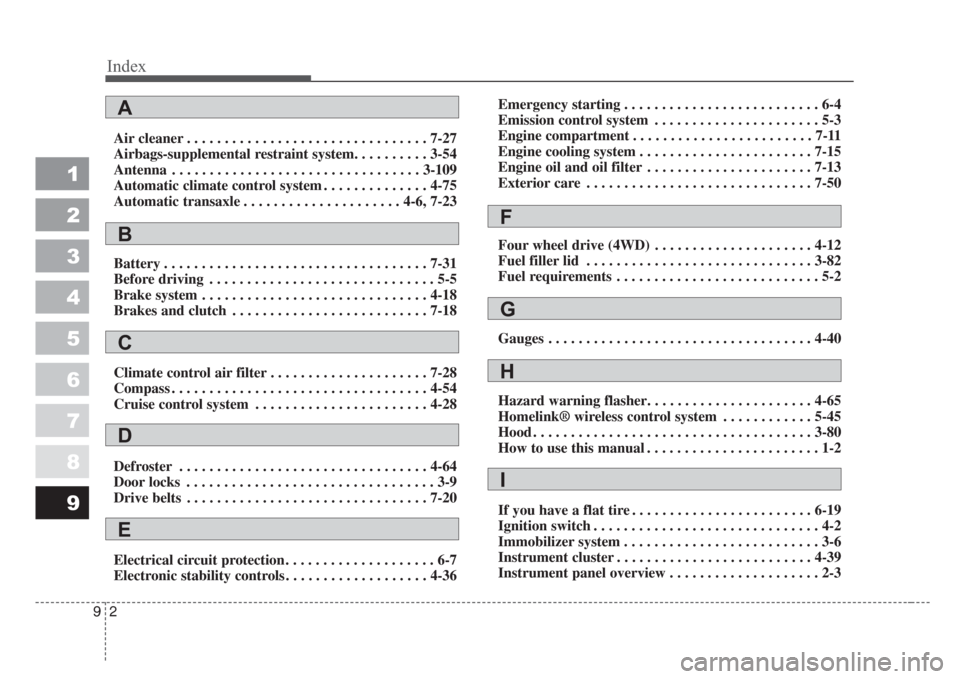
Index
2 9
1
2
3
4
5
6
7
8
9
Air cleaner . . . . . . . . . . . . . . . . . . . . . . . . . . . . . . . . 7-27
Airbags-supplemental restraint system. . . . . . . . . . 3-54
Antenna . . . . . . . . . . . . . . . . . . . . . . . . . . . . . . . . . 3-109
Automatic climate control system . . . . . . . . . . . . . . 4-75
Automatic transaxle . . . . . . . . . . . . . . . . . . . . . 4-6, 7-23
Battery . . . . . . . . . . . . . . . . . . . . . . . . . . . . . . . . . . . 7-31
Before driving. . . . . . . . . . . . . . . . . . . . . . . . . . . . . . 5-5
Brake system . . . . . . . . . . . . . . . . . . . . . . . . . . . . . . 4-18
Brakes and clutch . . . . . . . . . . . . . . . . . . . . . . . . . . 7-18
Climate control air filter . . . . . . . . . . . . . . . . . . . . . 7-28
Compass . . . . . . . . . . . . . . . . . . . . . . . . . . . . . . . . . . 4-54
Cruise control system . . . . . . . . . . . . . . . . . . . . . . . 4-28
Defroster . . . . . . . . . . . . . . . . . . . . . . . . . . . . . . . . . 4-64
Door locks . . . . . . . . . . . . . . . . . . . . . . . . . . . . . . . . . 3-9
Drive belts . . . . . . . . . . . . . . . . . . . . . . . . . . . . . . . . 7-20
Electrical circuit protection. . . . . . . . . . . . . . . . . . . . 6-7
Electronic stability controls . . . . . . . . . . . . . . . . . . . 4-36Emergency starting. . . . . . . . . . . . . . . . . . . . . . . . . . 6-4
Emission control system . . . . . . . . . . . . . . . . . . . . . . 5-3
Engine compartment . . . . . . . . . . . . . . . . . . . . . . . . 7-11
Engine cooling system . . . . . . . . . . . . . . . . . . . . . . . 7-15
Engine oil and oil filter . . . . . . . . . . . . . . . . . . . . . . 7-13
Exterior care . . . . . . . . . . . . . . . . . . . . . . . . . . . . . . 7-50
Four wheel drive (4WD) . . . . . . . . . . . . . . . . . . . . . 4-12
Fuel filler lid . . . . . . . . . . . . . . . . . . . . . . . . . . . . . . 3-82
Fuel requirements . . . . . . . . . . . . . . . . . . . . . . . . . . . 5-2
Gauges . . . . . . . . . . . . . . . . . . . . . . . . . . . . . . . . . . . 4-40
Hazard warning flasher. . . . . . . . . . . . . . . . . . . . . . 4-65
Homelink® wireless control system . . . . . . . . . . . . 5-45
Hood . . . . . . . . . . . . . . . . . . . . . . . . . . . . . . . . . . . . . 3-80
How to use this manual . . . . . . . . . . . . . . . . . . . . . . . 1-2
If you have a flat tire . . . . . . . . . . . . . . . . . . . . . . . . 6-19
Ignition switch . . . . . . . . . . . . . . . . . . . . . . . . . . . . . . 4-2
Immobilizer system . . . . . . . . . . . . . . . . . . . . . . . . . . 3-6
Instrument cluster . . . . . . . . . . . . . . . . . . . . . . . . . . 4-39
Instrument panel overview . . . . . . . . . . . . . . . . . . . . 2-3
A
B
C
D
E
G
F
H
I